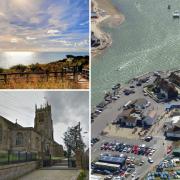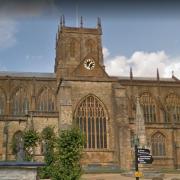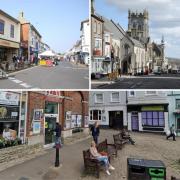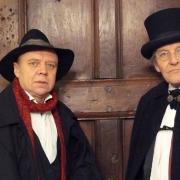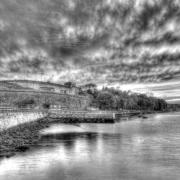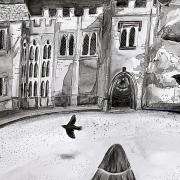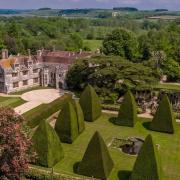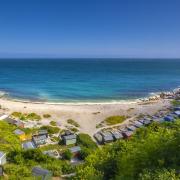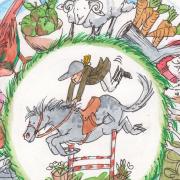John Craxton – Sir David Attenborough’s favourite painter - went his own way from the outset. Ian Collins, curator of a new Craxton exhibition in Dorchester, reveals how this maverick spirit went from Cranborne Chase to painting under bright Cretan skies

In between the wars an artistic lad called John Craxton (1922 – 2009) attended numerous schools before being pronounced unteachable. The life-long nomad then educated and liberated himself in the wilds of Dorset.
Born into a large, musical and bohemian family in London – the sort of household where people came for lunch and stayed for two years, but where sons were sent away and largely left to their own devices – Craxton always made the most of his freedom.
Lucky all his life, his greatest piece of good fortune was in having a welcoming uncle and aunt in the Minchington Valley. After a single unhappy term at Clayesmore School, Iwerne Minster, he came to look on their ancient cob-and-thatch cottage as his second home.
Both Cecil and Amy Waller were artists, all their wayward nephew ever wanted to do was draw and paint, and revel in a secret world of art, nature, history and legend – as provided by Cranborne Chase all around them.
As Craxton recalled in the 1990s: “The Dorset landscape is not an obvious physiognomy but, like a person, has many hidden aspects – the mysterious enigmatic earthworks, tumuli and barrows, the atmosphere of conspiracy from the great days of smuggling still lingers, the deep, impenetrable forests with King John’s hunting lodge to prove that time is ever relative.
“Nearby Knowlton Church could have been a set from an M.R. James ghost story, and had me in awe from the first - a ruin in the middle of a double prehistoric earthwork, the pagan temple and the Christian church each crumbling away back to earth.”
Better yet, the Waller’s cottage was within a short walk of the Pitt-Rivers Museum at Farnham – a private treasure house open to the public, where a solitary boy could wander at will. This Aladdin’s Cave became Craxton’s university.
Built in 1880 by Lieutenant General Pitt-Rivers, the museum taking his name held anthropological and social historical collections, as well as archaeological finds from Cranborne Chase and elsewhere.
The eclectic museum, which subsequently closed in the 1960s, lay within the Larmer Grounds – a pleasure gardens complete with bandstand, Indian Houses from the Great Exhibition, racecourse, golf links, open-air theatre and exotic animals.

Charming, amusing and handsome, Craxton was to benefit greatly from a Dorset chain of friendship. Pitt-Rivers Museum curator Trelawney Dayrell Reed introduced him to archaeologist Stuart Piggott, in whose house he met writer and academic Lord David Cecil. He in turn connected Craxton to novelist L.P. Hartley (The Go-Between) and, best of all, designer and painter E.Q. Nicholson.
Born Elsie Queen Myers, E.Q. as she was known, had married artist Ben Nicholson’s modernist architect brother Kit in 1931, and was now seeking a Dorset bolt-hole from the Blitz with their three children. Days after the Craxton family home was bombed in London, the evacuees moved into Alderholt mill house near Fordingbridge. Craxton went too.
“It was in her hospitable house that I really started to find myself,” he would remember. “We really had rather a pleasant war,” E.Q. recalled. “Looking after the chickens, and gardening and painting. Looking after John Craxton and the children.”
But Craxton’s art from this period tells a different story. He had been sketching in Paris into the summer of 1939 and then ‘been forced to retreat to England as war loomed. For the next six years of conflict his pictures, while displaying a precociously free talent, would be studies in entrapment.
He depicted lonely figures in Dorset-based landscapes menaced by a war which was never actually seen. His models were called poets, shepherds, dreamers or dancers – but all were emblematic portraits of the artist himself, in search of a lost Arcadia.
He completed his first masterpiece – Poet in Landscape – when aged 19 and newly rejected for military service due to “pleurisy” (almost certainly undiagnosed tuberculosis). He is the poet, reading a volume of poems by William Blake while awaiting the army doctor’s verdict.
Around this time he became best friends with Lucian Freud – an artist of the same age, with a similarly burgeoning talent and anarchic wit (causing his expulsion from Dorset’s Bryanston School).
A patron paid the rent on a London maisonette, where Craxton and Freud each had a studio for much of the war. But they were very often to be found in Dorset, larking and lodging at Alderholt with E.Q. Nicholson while working on wildly inventive paintings and drawings.
In 1944 the trio holidayed in Swanage – but Craxton and Freud longed for a more dramatic escape. A year later, in the first summer of peacetime, the two painters (already famous through their first shows in London) got as far as the Scilly Isles. They stowed away on a Breton fishing boat, hoping to see Picasso and Paris, but were discovered and ejected during a customs check in Penzance.

Then, in 1946, John Craxton – who needed a hot, dry climate for his health as well as his spirits – charmed the wife of the British Ambassador to Athens at a dinner party in Switzerland. He had been given a show in Zurich; she had borrowed a bomber to buy curtains for the embassy. She gave him a lift to the land of his dreams.
Lucian Freud followed his friend to Greece for the winter. Although returning regularly to Dorset – visiting widowed Aunt Amy until she died on the eve of her 101st birthday – Craxton was hooked forever.
His eventual home in Crete was visited by many notable friends – including writer Patrick Leigh Fermor (for whom he designed beautiful book jackets), dancer Dame Margot Fonteyn and naturalist Sir David Attenborough.
Sir David had bought a Craxton painting (“exultant and magically coloured”) before asking to meet the painter. Eventually he made a film on his artist friend (which is being looped into the Dorchester show) and gave the address at his 2010 memorial service.
“In Crete John learned what he described as a very salutary lesson for a painter – that life is more important than art,” says Sir David. “Those are his words. And he certainly relished life to the full.
“He enjoyed riding across Europe on his Tiger Triumph motorcycle. He loved parties, enjoying them both in embassies and village bars with equal gusto. He loved food – particularly eccentric, unusual food. One of my great pleasures in life was to be taken by John to his favourite harbour side restaurant in Chania and be given a dish of boiled sea-creatures which even I, who am supposed to have some knowledge of the animal kingdom, found hard to identify.”
Sir David, a special guest at the launch of the Dorchester exhibition, then adds: “If he did ever find Arcadia, he found it in Crete, and we must all be deeply grateful to him for bringing that vision of it into our lives so eloquently, so vividly and so unforgettably.”
Visit the Exhibition

A Poetic Eye: John Craxton on Cranborne Chase and Crete is at Dorset County Museum 28 March – 19 September. As well as including many Craxton works the wide-ranging show also features local landscapes by his gifted uncle, Cecil Waller, and treasures of world art formerly in the Pitt-Rivers Museum, Farnham.
***
READ ON
• Niche Dorset prop hire business - Gemma Taylor at ‘Prop Dead Gorgeous’ - It’s not every day you meet a girl in wellies sitting beneath a fake tree, alongside a giant cupcake, a fibreglass poodle, a four-foot high toy soldier and a Dalek.
• Meeting world class ukulele maker Toby Chennell - He can’t play a note and has even carved up the furniture in his Bournemouth workshop to make an instrument. Meet world class ukulele maker Toby Chennell.




